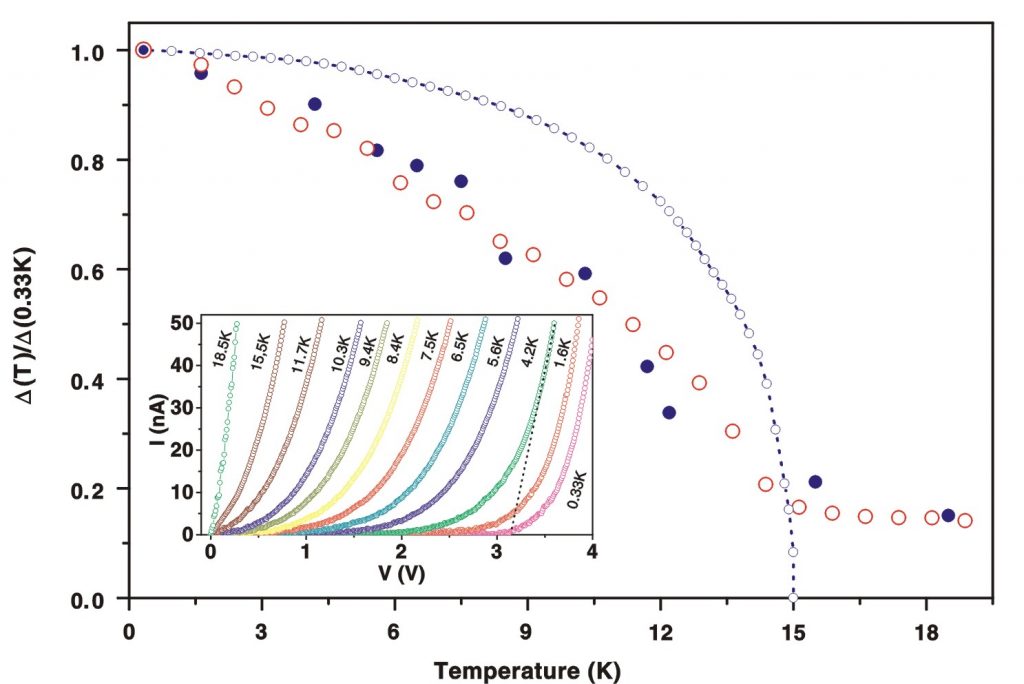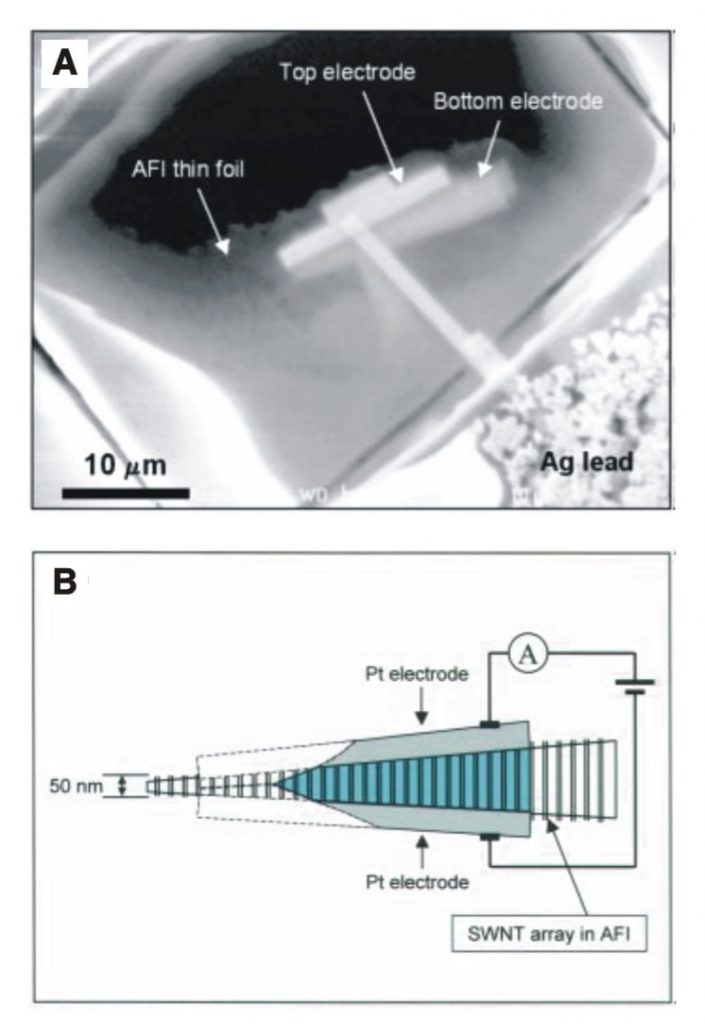Following on the success of Zikang Tang in fabricating 4-Angstrom single-walled carbon nanotubes (which are at or close to the theoretical limit of nanotubes’ diameter) and Ning Wang’s direct TEM visualization of these nanotubes, superconductivity has been discovered in these nanotubes. This discovery followed a rather tortuous path, somewhat interesting in its own right. Hence I record it here. The related work was started in 1997-98, when measurement of low temperature electrical transport through the nanotubes, by Jiannong Wang, uncovered a rather sudden disappearance of charge carriers below 12 kelvin. Recognizing the importance of this result, Ping organized efforts to elucidate the underlying cause of this intriguing phenomenon. A casual visit by Steve Louie (UC Berkeley) has brought the attention to a 1995 paper by himself, Marvin Cohen, and their collaborators, predicting superconductivity in carbon nanotubes with increased transition temperature as the diameter decreases. With this jolt, Ping persuaded Xixiang Zhang and his student to measure the Meissner effect. The positive result on the Meissner effect clarified, for Ping at least, the earlier observed phenomenon of the disappearance of the charge carriers (caused by the opening of the superconducting gap at the Fermi level). The physical picture is that of nanotubes with superconducting segments separated by potential fluctuations caused by imperfections. However, at that point there was still much skepticism by Ping’s colleague(s), and even by Ping himself, on nanotube superconductivity because of the following two factors. First, the observed Meissner effect is not like the conventional one at all. Second, at low temperatures what was observed up to that point were insulating behaviors, hardly the support needed for superconductivity. For the first point, Ping proposed the use of Ginzburg-Landau free energy functional and functional integral calculations to see if the observed behavior conforms with that of one dimensional fluctuations. This was carried out by Lingyun Zhang, the postdoc from Beijing’s Institute of Theoretical Physics. For the second point, Ping proposed to Ning Wang and Zikang Tang the fabrication of sample(s) consisting of very short nanotubes, preferably less than 1000 Angstroms. This was brilliantly carried out by Ning Wang, after some initial failures. The result was stunning and a happy surprise. The short nanotubes exhibit metallic temperature dependence below 10 kelvin. The conductivity increases several fold at low temperatures, with no saturation in sight even at 0.45 kelvin. This type of behavior is not typical of metal, whose conductivity tends to saturate at low temperatures. In fact all three phenomena- -the Meissner effect, the superconducting gap, and the fluctuation supercurrent seen in short nanotubes — can all be consistently explained by the predictions of the theory. It was at that point that the decision was made to proceed with publication of the results. It should be noted that a rather important aspect of this work is that the effective mass of the superconducting pair is much closer to the metallic (5,0) nanotubes, in accordance with the LDA calculations carried out by CT Chan, than to the (3,3) nanotubes. Since metallic nanotubes are usually taken to be (n,n), many of the conclusions that apply to such tubes would have to be modified before they can be applied to (5,0).


(B) A diagram of the sample
Key publications:
- “Superconductivity in 4-Angstrom Carbon Nanotube Arrays–A Short Review“, Z. Wang, W. Shi, R. Lortz and Ping Sheng, Nanoscale 4, 21-41, (2012).
- “1D goes 2D: A Berezinskii-Kosterlitz-Thouless transition in superconducting arrays of 4-Angstrom carbon nanotubes“, Z. Wang, W. Shi, H. Xie, T. Zhang, N. Wang, Z.K. Tang, X. Zhang, R. Lortz and Ping Sheng, Phys. Status Solidi B247, Nos. 11-12, 2968-2973 (2010).
- “Superconducting Resistive Transition in Coupled Arrays of 4 Å Carbon Nanotubes“, Z. Wang, W. Shi, H. Xie, T. Zhang, N. Wang, Z. Tang, X. Zhang, R. Lortz, I. Sheikin, A. Demuer and Ping Sheng, Phys. Rev. B81, 174530 (2010).
- “Superconducting Characteristics of 4-Å Carbon Nanotube-zeolite Composite“, R. Lortz, Q. Zhang, W. Shi, J. T. Ye, C. Qiu, Z. Wang, H. He, T. Qian, Z. Tang, N. Wang, X. Zhang, J. Wang, C. T. Chan and Ping Sheng, Proceedings of the National Academy of Sciences, 106, 7299-7303 (2009).
- “Meissner Effect in a System of Coupled One-Dimensional Superconducting Wires Monte Carlo Simulations“, C. Qiu, T, Qian and Ping Sheng, Phys. Rev. B75, 024504 (2007).
- “Superconductivity in 4 Angstrom Single-Walled Carbon Nanotubes“, Z. K. Tang, Lingyun Zhang, N. Wang, X. X. Zhang, G. H. Wen, G. D. Li, J. N. Wang, C. T. Chan, and Ping Sheng, Science 292, 2462-2465 (2001).